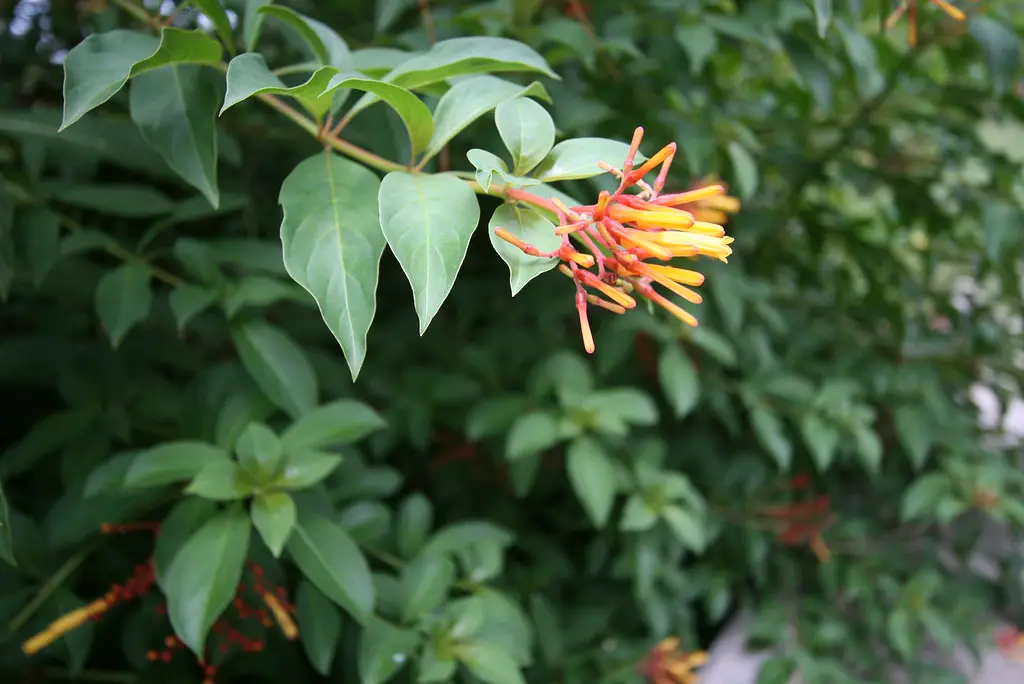Firebush, scientifically known as Hamelia patens, is an attractive shrub famous for its vibrant red-orange flowers that bloom throughout the year. This tropical plant is a favorite among gardeners for its ability to attract hummingbirds, butterflies, and other pollinators. Native to Southern Florida, Mexico, Central America, and South America, Firebush is known for its adaptability to various growing conditions and resistance to pests and diseases.
The shrub’s unique, tubular flowers are not only eye-catching but serve as a nectar source for various beneficial insects. Firebush’s lush green leaves and showy, clustered flowers make it a stunning addition to gardens, whether planted as a hedge, border, or accent plant.
Firebush’s rapid growth and minimal care requirements make it a popular choice among both novice and experienced gardeners. Its ability to thrive in different climates and soil types makes it versatile and suitable for various landscaping needs.
| Attribute | Details |
|---|---|
| Common Names | Firebush, Hummingbird Bush, Scarlet Bush |
| Botanical Name | Hamelia patens |
| Family | Rubiaceae |
| Plant Type | Perennial Shrub |
| Mature Size | 5-15 feet tall, 3-5 feet wide |
| Sun Exposure | Full Sun to Partial Shade |
| Soil Type | Well-draining soil |
| Hardiness Zones | 8-11 |
| Native Area | Southern Florida, Mexico, Central America, South America |
Firebush Care
Firebush is a low-maintenance plant, requiring minimal attention to thrive. It is well-suited for areas with full sun, although it can tolerate some shade. The plant prefers well-draining soil but can adapt to various soil types, including sandy, loamy, or clay soils.
Watering requirements for Firebush are moderate, with the need for more frequent watering during its establishment phase. Once established, the Firebush exhibits good drought tolerance, making it a suitable option for xeriscaping. Regular pruning helps maintain the shape and encourages bushier growth.
Light Requirement for Firebush
Firebush thrives in full sun but can tolerate partial shade. Placing the plant in a location with ample sunlight encourages vibrant flower production and healthy foliage growth. Insufficient sunlight may lead to reduced flowering.
Soil Requirements for Firebush
Firebush can adapt to a variety of soil types but prefers well-draining soil. Soil that retains moisture without becoming soggy is ideal for healthy growth. The plant can grow in sandy, loamy, or clay soils and has a pH tolerance range of 6.1 to 7.8.
Water Requirements for Firebush
Firebush needs moderate watering, especially during the initial establishment phase. Once established, it exhibits good drought tolerance. Overwatering or waterlogged soil should be avoided, as it can lead to root rot.
Temperature and Humidity
Firebush prefers warm temperatures and can tolerate high humidity. It thrives in USDA hardiness zones 8-11 and can handle occasional dips in temperature. In colder regions, it may die back in winter but often regrows in spring.
Fertilizer
Fertilizing Firebush is typically unnecessary. However, if desired, a general-purpose garden fertilizer can be applied in the early spring to promote vigorous growth and blooming.
Pruning Firebush
Regular pruning of Firebush helps maintain the desired shape and encourages bushier growth. Cutting back leggy growth and deadheading spent flowers can improve the plant’s appearance.
Propagating Firebush
Firebush can be propagated through softwood cuttings or by dividing established plants. Cuttings should be taken during the growing season and rooted in a well-draining growing medium.
How To Grow Firebush From Seed
Growing Firebush from seed is possible but can be more challenging. Seeds should be sown in a well-draining soil mix and kept warm and moist. Germination can take several weeks, and patience is required for successful seed propagation.
Common Pests & Plant Diseases
Aphids
Aphids may be attracted to Firebush but can be easily treated with insecticidal soap or neem oil.
Root Rot
Caused by overwatering or poor drainage, root rot can be avoided by using well-draining soil and avoiding overwatering.
Common Problems With Firebush
Legginess
This can occur with insufficient sunlight or infrequent pruning. Increasing sun exposure or regular pruning can correct the problem.
Flowering Reduction
A lack of flowers may result from inadequate sunlight or poor soil conditions. Adjusting these factors can improve blooming.
Pro Tips
- Plant Firebush in a sunny location to maximize flowering.
- Water moderately and ensure proper soil drainage to prevent root rot.
- Consider Firebush for butterfly gardens, as it attracts various pollinators.
- Prune regularly to maintain shape and encourage bushy growth.
- Use Firebush as a stunning focal point or accent in tropical-themed landscapes.




